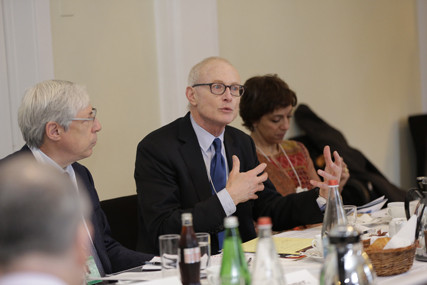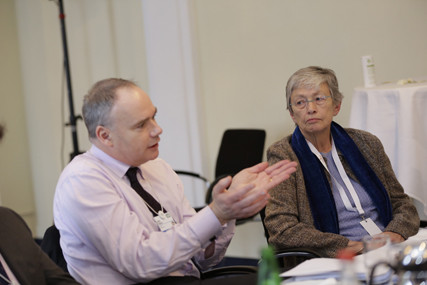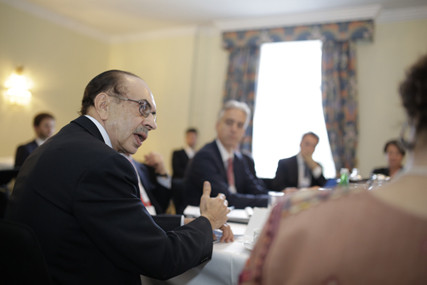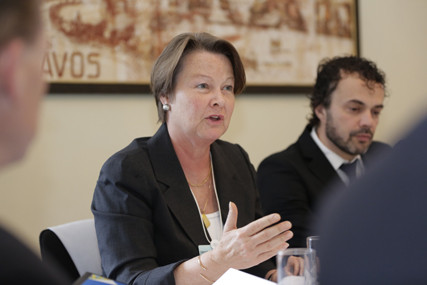 Roundtable participants at the Steigenberger Grandhotel Belvedere in Davos, Switzerland.
Roundtable participants at the Steigenberger Grandhotel Belvedere in Davos, Switzerland.
Companies across industries—including education, technology, financial services, agriculture, and more—are beginning to play a new role in education, one that improves learning outcomes while driving shareholder returns. Rather than viewing education solely as a matter of philanthropy or responsibility, these companies are also tackling education issues through their core business strategy and operations. In doing so, they are creating the power to scale solutions to our world’s greatest education problems far beyond what they could do with limited giving budgets.
This new approach leverages the concept of shared value to help companies find new ways to grow revenue and increase productivity by raising levels of student and workforce achievement. (See “Creating Shared Value,” Harvard Business Review, January 2011, by FSG co-founders Michael Porter and Mark Kramer.) In education, companies create shared value in two fundamentally different ways. First, companies that are in the business of selling products to the education sector (such as Pearson, Lego, and Intel) can create shared value by developing cost-effective products that improve learning outcomes and enable them to gain competitive advantage based on student success. Second, companies across all industries that are constrained by skills shortages can create shared value by sourcing and training the employees, suppliers, and customers they need to grow their business. In both instances, taking a shared value approach enables business to transform from a passive consumer of talent to an essential partner to schools, nonprofits, and governments in overcoming the global education crisis.
More and more companies have begun to create shared value over the last decade. Relatively few, however, have applied this approach to education, as it has historically been viewed as the realm of government and the timeline to see results can be long. Yet changing market dynamics—including disruptions in technology, a growing global middle class, and a rising demand for quality—are shifting traditional mindsets and opening new opportunities for business. To discuss these opportunities, 17 corporate and global education leaders gathered on Jan. 24, 2014 at the World Economic Forum annual meeting in Davos, Switzerland. They were brought together by FSG and the Stanford Social Innovation Review. Some of the companies—such as Pearson, Discovery, Lego, Intel, and Microsoft—have been investing in education for decades. Others—such as Western Union, Godrej, Nestlé, and Accenture—are newer to field. But all of the participants—which also included those in the nonprofit space such as the Global Partnership for Education, Ford Foundation, Education for Employment, Omidyar Network, and the International Youth Foundation—see the enormous potential for the future.
The conversation, led by Kramer and Porter, explored how companies and their partners are leveraging the power of business to improve education and what’s needed to drive even greater change. We discussed how technology is enabling new learning to occur for both customers and suppliers. How companies are using this information to define explicit outcomes for the first time, and how these outcomes will vary based on what problems they are trying to solve. How shared value can help tackle some parts of the problem but is not necessarily the answer for everything. And how collective action is needed above all—among and between companies, nonprofits, and governments—to build end-to-end solutions that address the full scope of our global education crisis.
ROUNDTABLE PARTICIPANTS:
Are you enjoying this article? Read more like this, plus SSIR's full archive of content, when you subscribe.
Kerry Agiasotis, managing director of Business Solutions, Western Union
Matt Bannick, managing partner, Omidyar Network
Carol Bellamy, former executive director of UNICEF and former board chair of Global Partnership for Education
John Fallon, CEO, Pearson
Adi Godrej, chairman, The Godrej Group
Bill Goodwyn, CEO, Discovery Education
Jill Huntley, managing director of Corporate Citizenship, Accenture
Jacob Kragh, president, Lego Education
Mark Kramer, co-founder and managing director, FSG
Jamie McAuliffe, CEO, Education for Employment
Christian Morales, vice president, Intel Europe, Middle East and Africa
Eric Nee, managing editor, Stanford Social Innovation Review
Michael Porter, Bishop William Lawrence University Professor, Harvard Business School
Kavita Ramdas, representative, Ford Foundation—India/Nepal/Sri Lanka
William Reese, CEO, International Youth Foundation
Brad Smith, executive vice president and general counsel, Microsoft
Janet Voûte, global head of Public Affairs, Nestlé
Mark Kramer: Let’s start with the question of bringing the profit motive into education. Michael, why should business take a role in education to improve stakeholder returns rather than just philanthropy?
 Mark Kramer, FSG; Michael Porter, Harvard Business School; and Kavita Ramdas, Ford Foundation.
Mark Kramer, FSG; Michael Porter, Harvard Business School; and Kavita Ramdas, Ford Foundation.
Michael Porter: Capitalism is a magic thing—if you can actually meet a real need and actually do so profitably, wealth is created in society. Government can’t create wealth. NGOs can’t create wealth. They can do great things, but they can’t actually create wealth. The creation of wealth is fundamentally from capitalism, and if you can apply the capitalist model to education, you get the enormous benefit of scalability. You get the opportunity of being self-sustaining. You have the opportunity to spread the benefits you provide to more and more people, and in that process you get more efficient and more effective at it. Costs go down and efficiencies go up. If we can supplement the traditional model of paying taxes and putting money into public schools and making charitable contributions with the right dose of capitalism—with the right objectives and the right alignment to the real needs of society—then we can gain enormous power to change the field of education.
Eric Nee: Education is not only one of our most pressing social issues, but also one of our greatest opportunities to create cross-sector solutions. That’s because there’s natural alignment between the interests of business, government, and civil society when it comes to improving our educational system, and shared value helps us understand the role that business can play in creating and shaping those cross-sector partnerships. But, I want to be clear, as important as shared value is in solving our education crisis, it’s not a silver bullet. It does not address all of the problems our educational systems face, and it’s not easy to do. No doubt in some instances, it will create unintended consequences that will have negative impact on students. In other cases, it may fail. But in many other instances, it can and will have positive impacts. Done right, it can enhance our educational systems, and that’s what we want to talk about this morning.
Kramer: We have a lot to learn from the people at this table about how the power of business can be leveraged to positively change education. John, how is Pearson doing this, and what shifts are you making in your business to adopt a shared value approach to education?
 John Fallon, Pearson, and Carol Bellamy, Global Partnership for Education.
John Fallon, Pearson, and Carol Bellamy, Global Partnership for Education.
John Fallon: Shared value has always been implicit in what Pearson does as a company. We say our purpose is to help people make progress in their lives through learning. Yet until a few years ago, we were putting a whole series of inputs into the hands of teachers, school superintendents, and university professors, and it was very hard for us to measure in any objective way whether these inputs were leading to better outcomes for students. Over the last decade, the power of data and technology has enabled us to start creating a new generation of products that allow us to make shared value explicit. What we’ve created is what we call an “efficacy framework” which helps us answer four questions: 1) what’s the learning outcome we want to achieve, 2) how are we going to measure whether that value is created, 3) do we have the internal capacity to deliver on it, and 4) because we most often work in partnership with the community, what’s the external capacity that gives us confidence that we can deliver value? This is fundamentally changing the companies we acquire, the types of people we recruit, how we do our incentive plans, and how we report our work. To be clear, we are still learning. We’re on the path to efficacy, and we see it as a means of creating a much wider conversation and engagement with a much wider range of stakeholders. So, along with this, we have very significantly expanded our research capacity, and are trying to create a network of external research and bring best practices from around the world together. But as we know in teaching, all the best learning happens from the mistakes you make and the lessons that you learn from them, and that’s the same approach we need to take with this. I think the shared value to society, if we get it right, is enormous. I believe there is power for us to double learning outcomes over the next decade for about the same cost if we can all work together far more effectively. The value to our shareholders is, I believe, that we will create a faster growing, more sustainable, more profitable business, because we are expanding our own market opportunity and, hopefully, we will enhance our own innovation. We’ll create better products as a result.
Kerry Agiasotis: To pick up on what John said, Western Union is also undertaking significant shifts in the business to make shared value explicit. When you really understand Western Union and what it does, you see its attachment to education is intrinsic. Yet it took an impassioned leader, Hikmet Ersek, to recognize that. When Hikmet became CEO of the company in 2010, he had a different way of looking at the business and started with the customer—by drilling into understanding how remittances were being used across the 200 countries in the world that we are in, he realized that 30 percent of all remittances were somehow attached to education. He saw this as a huge business opportunity, and at the same time a way to expand Western Union’s value in the education ecosystem. From that point, Hikmet created a new Social Ventures team that found a number of opportunities to create sustainable financial products that drive efficiencies in education. We deal with about 700 educational institutions around the world that are focused on educating people abroad. So in the last 12 months for example, we would have dealt with over 60,000 individuals supporting international student payments, and 700 organizations receiving those payments and driving efficiencies in the ecosystem from a foreign exchange and payment standpoint.
Bill Goodwyn: For Discovery Education, there is perfect alignment between shared value and education. If we’re not delivering and improving student outcomes, if we’re not teaching and learning, we will not have a profitable business. So we have begun to work very closely with school districts to measure our success. For example, in Collier County, Florida, we’re looking at science scores to assess the effectiveness of our science digital textbooks. Just this past week, the FCAT (Florida Comprehensive Assessment Test) scores for fifth and eighth graders in the district showed significant increases. In Miami Dade (the fourth largest school district in the United States), we started working with their Title I schools just a few years ago and since then, because we’ve performed, our products and services are being scaled district-wide. Our growth in school districts is tied to student outcomes. Years ago, a lot of companies made a lot of money without delivering results. Today, the only way you’re going to be a profitable, sustainable, long-term business in education is by delivering outcomes.
 Adj Godrej, The Godrej Group.
Adj Godrej, The Godrej Group.
Adi Godrej: As the largest conglomerate in India, the Godrej Group approaches this topic from a different angle. India’s major problem is its shortage of skilled talent. It’s a problem for youth, as well as for people in their 30s or 40s that need to be reskilled and retrained. It’s also a problem for business in India. We have businesses across real estate, consumer goods, appliances, and agricultural products, and we’re growing 15 to 20 percent each year. So we made a long-term commitment to skill and train one million young people over a 10-year period. It’s a win-win. It will benefit the people, our businesses, and the country. I’ll give a couple of examples. We are leaders in the hair color business in India, so we have a program that trains young women to provide salon services from their homes. It helps our business, and it helps thousands of women get income and employment. We are leaders in the animal feed business, so we’re training thousands of youth to do poultry farming in addition to their agricultural pursuits. We’re in the real estate business, so we help train construction workers. We employ people in various consumer products businesses, so again, we are training people to be efficient salesmen and saleswomen. These programs add tremendous value to people’s lives and can help accelerate India’s GDP growth considerably.
Jacob Kragh: Lego works at a much earlier stage in the education pipeline. We’re creating a business where we are developing resource sets, curriculum, teacher training, and really what John was referring to around a new pedagogy—a new way of involving children and students to take active ownership of their learning. We’ve found when kids are given the right instruments, they’re very likely to take leadership of their own education. But they need incentive and the right tools to do so. Lego works closely with teachers to develop materials that allow them to engage and motivate students so they feel that coming to school is the best thing they could ever do.
Kramer: It’s clear that education presents immense opportunity for companies across industries to create shared value. Before we dive into some other questions, let’s discuss the role of technology in education. Christian and Brad, what are Intel and Microsoft doing?
Christian Morales: Intel invests more than $100 million a year in education, and we have trained 10 million teachers around the world. We teach teachers how to use technology to create much more interactive content in the classroom than they use today in order to improve the learning experience. We also work with governments to embed technology in schools. For example, we’re working with the government of Portugal to transform the country’s primary education system with 1:1 technology integration. The project combines age-appropriate technology and content with the training, support, and Internet connectivity students need to develop 21st century skills. Since 2008, we helped deliver broadband Internet access to all schools in the country, and equip all students in grades 1 to 4 (more than 750,000 students) with a locally produced computer that uses the Intel-powered classmate PC design. Since launching this project, we’ve seen students PISA (Programme for International Student Assessment) scores rise by 20 percent. And this created $2.5 billion of additional revenue for Portugal.
Brad Smith: For Microsoft, the education sector has been a major customer for software for 25 years. We’ve been serving schools, school districts, and universities around the world for decades. But what’s interesting is to step back and really ask ourselves what is old and what is new. I’d say the concept of shared value is not a new concept. When a customer pays you money, you’re supposed to deliver a product or service that has value. So that part is not new, but three things are new that make this really remarkable. First, schools, as customers, are recognizing that they’re not delivering the outcomes they’ve tried to achieve in some parts of the world. Second, the rise of big data and access to new technologies has made it possible for lots of new learning to occur—and the learning isn’t confined to the customer, it’s opened up to the supplier as well. Third, and I think this is where the concept of shared value is quite new, we’ve all learned that we can innovate to improve our services and goods, but in order for schools to use them to improve outcomes, they’ll need to innovate in the way they do their job as well. We have an interconnected path in innovation, and, I would say, these three concepts together put us in a new era.
Kramer: The real test for creating shared value is whether you’re explicitly trying to measure outcomes, and then connecting how improving those outcomes makes the business more productive. But there is a lot of debate in education around what constitutes a good outcome. How do you define outcomes?
Kavita Ramdas: This is an important question. One of the barriers to creating shared value in education is that there is a distinct divide between those who work in education and view outcomes from a societal perspective and those who work in the private sector and view outcomes from a business perspective. Having good test scores is not necessarily an indicator of someone who can manage in this economy. In the context of India, for instance, reading and writing doesn’t necessarily improve a woman’s role and position within society. So, what do we actually mean by good outcomes? Are we merely talking about test scores, or are we talking about something more?
Fallon: I would argue that outcomes should vary significantly from activity to activity, but that we consider three broad elements: 1) thinking skills, such as how you apply literacy, numeracy, and scientific knowledge, 2) intrapersonal skills, like determination, sense of responsibility, and self-worth, and 3) interpersonal skills, such as the ability to communicate, work collaboratively, and problem-solve, which is what most major companies would say is in greatest demand. What is helpful about where we’re at is that for the first time we are being explicit about what outcomes we’re trying to achieve. If there is disagreement, we can work it through, but having a framework that enables this societal debate to happen is critical.
Smith: Yes, the business community today is playing a more activist role with respect to education than it ever has before, because we have a real business problem: We have unfilled jobs ironically at the same time as youth unemployment is at crisis peaks. The most powerful thing I’ve ever heard said about what business can do in education was by Steve Ballmer (former Microsoft CEO) about 10 years ago. Like a lot of us, Steve travelled around the world and made announcements. He came back one time and said to me, “I’m giving all of these nice announcements, but I feel like I’m traveling with a pop gun. Everywhere I go, it goes pop. It makes some noise. Is it really making a difference? What is the real impact of what we do, or are we just a company with a bunch of pop guns?” This is where I think we could really do something important together, especially as business, is playing a more active role in trying to improve education. The most important question to ask is not, “What are we doing?” but “What are we learning?”
 Janet Voûte, Nestle, and Jacob Kragh, Lego Education.
Janet Voûte, Nestle, and Jacob Kragh, Lego Education.
Janet Voûte: At Nestlé, we’ve launched a new youth employment initiative in Europe with a commitment to hire 20,000 young people, including trainees and apprentices, by 2016. The outcome for these young people is employment and experience, but the right preparation and education is key. Likewise in our Nestlé Healthy Kids program, which includes a nutrition education program, the desired outcome is to get nutrition education back into the public school system. Although Nestlé is not directly engaged in the education space, it is important to us. As a nutrition, health, and wellness company, we are looking for very specific education outcomes, and those outcomes depend upon where you are. If you’re supporting nutrition education in a place where micronutrient deficiencies are the main problem, you’ll have a different curriculum than in those places where you’re facing obesity problems.
Kragh: For Lego, the problems we are trying to solve vary and therefore will have very different outcomes. In some countries the challenge is getting kids to come to school. In others, it is about creating a new generation that is equipped with the skills to become creative and imaginative learners so students can innovate the next iPad in 20 years. There is not just one measure of success for us in the field.
Kramer: Let’s turn to the role of the nonprofit sector. How can nonprofits work with business to create shared value in education?
William Reese: The International Youth Foundation works with companies all over the world to co-design assets that will deliver business value. Today, for example, we work with Hilton, Caterpillar, McDonald’s, and Walmart to help develop their future employees. We create programs that equip students with not only technical skills, but to John’s point, life skills as well. We are helping these huge employers employ the types of people they need—not just by preparing them for their first job, but by preparing them for a career. In this instance, the measures of success will be if these employees are promotable in 6 months, or 12, or 18, and if these programs help lower training costs.
Jamie McAuliffe: Education for Employment partners with businesses throughout the Middle East and North Africa to identify skill needs and train young people in those specific areas. We’ve built a board of directors made up of business leaders from key sectors who advise us on our strategy and hire us to train students to meet their company’s needs. We are a logical platform to enable a shared value approach to youth unemployment. To truly address youth unemployment at scale, shared value needs to be married to FSG’s other great framework, collective impact. The solution needs to be companies within sectors and within countries coming together to say “We’ve got to address this as a sector, as a shared collective responsibility for advancing opportunities for youth.” I’m really encouraged by what we’re seeing in the tourism industry and sectors in India where companies are coming together to skill up hundreds of thousands of young people to fit that industry. It’s not just about the needs of one company, and that’s the type of collaboration we need to encourage more.
Jill Huntley: I would agree that collective action is needed and that it’s not easy. It takes time to bring together coalitions. From Accenture’s perspective, investing in education is critical as we are a very large human capital-based business. We have 280,000 employees and we’re growing fast. In order to find the talent we need in the future, there’s a case for us and many other businesses to find new models for investing in education that will bring our pipeline to life. In Spain, for example, we have entered into a very significant collective action initiative that involves 17 government agencies, 30 to 40 private companies, and the same number of nonprofits. It’s a powerful vehicle, but it takes time to convene that number of organizations and to really execute on that. So I would argue there is a call for collective action, but also a call for patience and tenacity.
Kramer: We’ve discussed a lot of good ideas today about what’s needed for companies to create greater value in education. Looking forward, what do you believe is most needed on the global agenda for action?
 Mark Kramer, FSG.
Mark Kramer, FSG.
Ramdas: We need a core group of leading companies to come together with a few civil society partners to make a clear commitment to education and say, “These are the five things that we really want to achieve. These are the numbers. This is what we are looking to do in the developing world. This is what we think we need to still do in the developed world. This is where we want to arrive.” We know that a number of these relationships already exist, even around this table. This would be a very big first step.
Carol Bellamy: Yes, a network of leaders from the private sector is needed and is not yet fully developed. We also need common goals and a better understanding of what we are learning. What successes and failures can we learn from? One of the things we deal with in education is a lack of connectedness between government, business, and nonprofit systems. Looking at these connections and learning what’s worked and what hasn’t from across systems will allow for better solutions. We need to move from the transactional relationship between individual companies and the education system to a comprehensive and coordinated approach in which companies align their offering around agreed upon goals with accountability for their results.
Huntley: I certainly agree with the comments around bringing together a network and focusing on what works. I would add that we focus on two things: 1) short-term remedial solutions that help fix the problems that already exist and help us get quick wins, and 2) long-term durable and structural changes that are required inside the education system or through the involvement of business.
Matt Bannick: There is great consistency in these comments. I would add that there is a lot of experimentation, and we need to find what’s really working and focus on scaling those solutions. Specifically, we need to better understand the role of technology in education, which has the potential to be enormously transformative. Just look at the Khan Academy. We’re at the very beginning of using technology in this way, yet the evidence suggests that these models could dramatically impact low-income students who tend to have less access to high-quality teachers. We need to gather and share more information on where these types of approaches are succeeding and failing, so we can incorporate these lessons into our work.
Goodwyn: To Matt’s point, I agree we need to shine the spotlight on technology. People talk about the importance of access in both developed and developing countries, and technology can help us with this. High-quality digital content and professional development can be a great equalizer between countries and communities around the world. If kids are not getting the 21st century skills they need in the classroom, they are often not getting them at home, and this is a real issue. Lastly, we need to shine the spotlight on where companies are succeeding in driving real outcomes. Whether it’s by delivering curriculum, nutritional advancements, financial literacy, or life skills—we need to share what companies are doing so we can partner and build end-to-end solutions. There are natural links between the issues that relate to different companies’ businesses. We cannot solve the whole scope of the education crisis alone, but together we can create enormous change.
Read the FSG report, The New Role of Business in Global Education.
Learn more about shared value by visiting the Shared Value Initiative website, or attending the Shared Value Leadership Summit.
NOTE: The first sentence of the article originally read as follows and was changed to be more precise. "Companies across industries—including education, technology, financial services, agriculture, and more—are playing a new role in education, one that improves learning outcomes while driving shareholder returns."
Support SSIR’s coverage of cross-sector solutions to global challenges.
Help us further the reach of innovative ideas. Donate today.
Read more stories by Kate Tallant & Mark Kramer.

